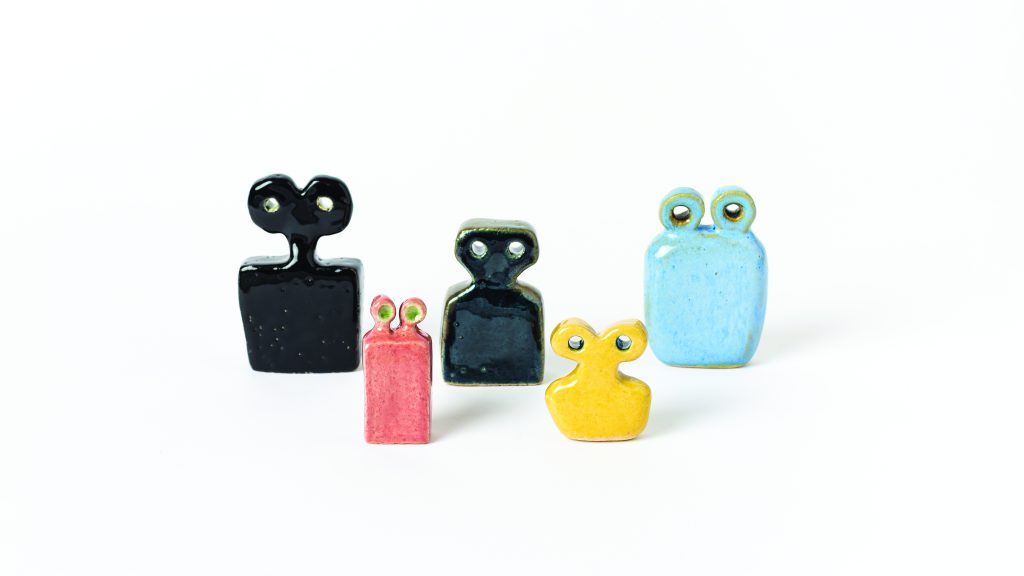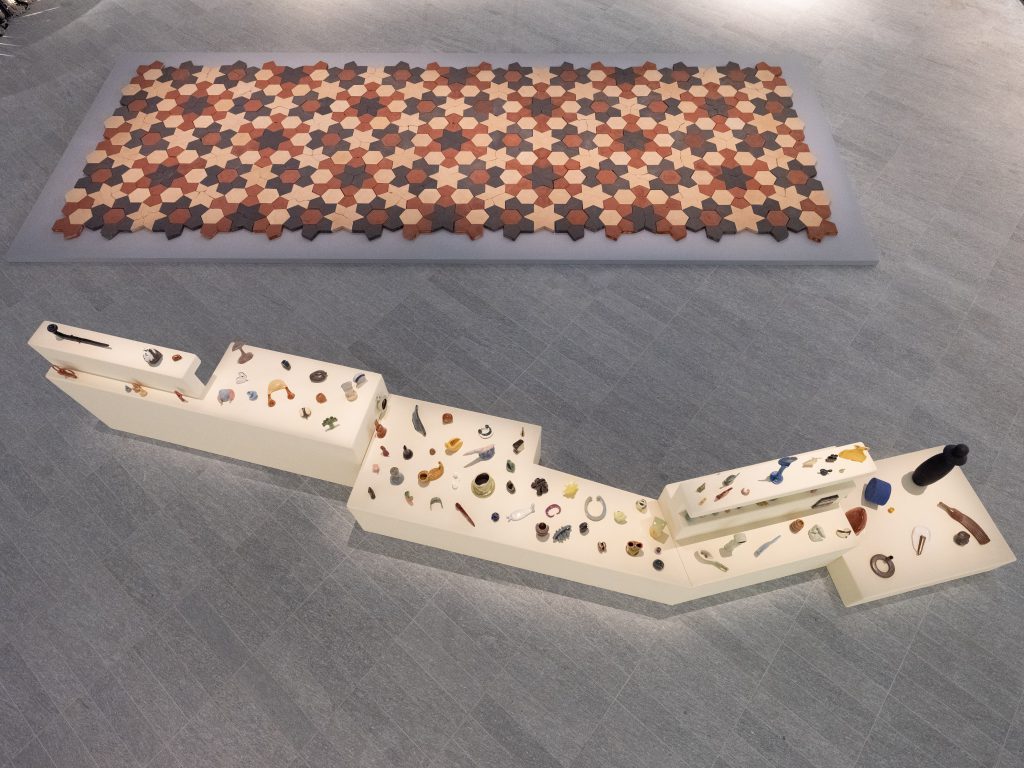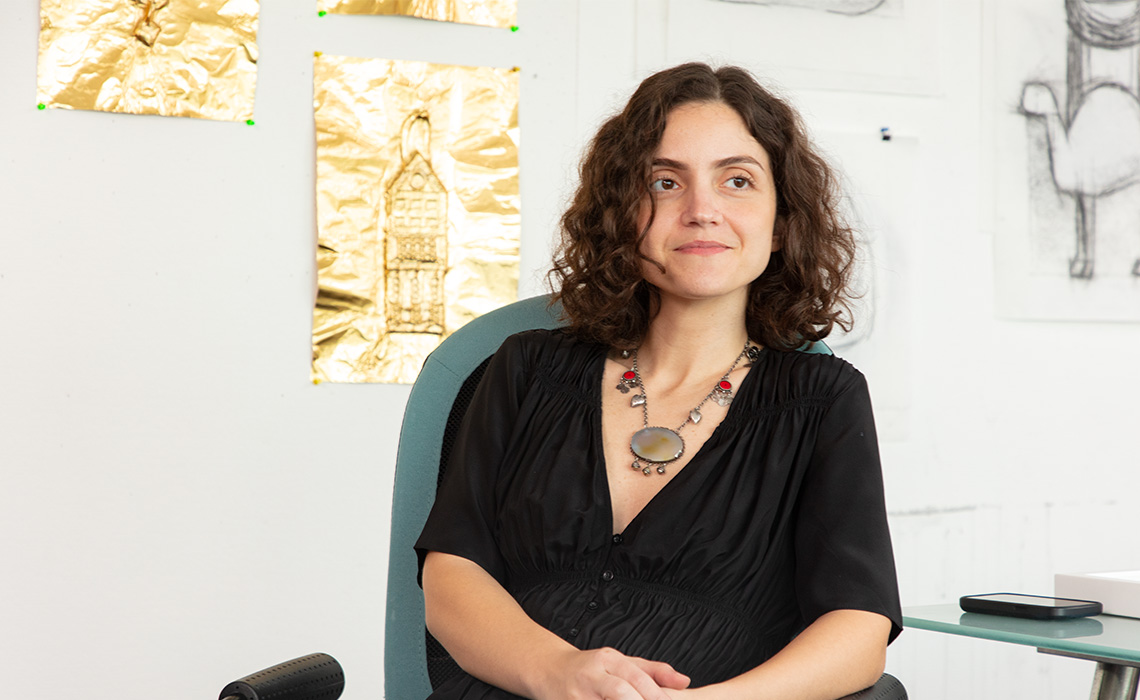For her series of elegant, abstract forms that echo ancient Mesopotamia, Baghdad-born Abu Dhabi artist and designer Rand Abdul Jabbar has been awarded the 2022 Richard Mille Art Prize.
Earthly Wonders, Celestial Beings (2019), Rand Abdul Jabbar’s ongoing series of clay sculptures, draws from the architecture, mythology, folklore and poetry of Iraq, which her family left when she was a small child. The project grew out of a 2016 exhibition Abdul Jabbar co-curated for the Iraq pavilion of Abwab at Dubai Design Week. When prompted to think about what contemporary Iraqi design looks like, she says, “We wanted to find a way to engage with the place by looking at it as a material/geographical body as opposed to a national entity, so we turned to land and earth, and therefore archaeology, as a way to think about a language that might respond to the significance of the place.” The result was Excavations, an installation presenting designed objects that recalled minarets and other Mesopotamian architectural forms.
Abdul Jabbar’s creative practice began with work as a designer. The Columbia graduate with an architecture degree was known for projects like Forma (2015), furniture inspired by traditional Arab dhow boats. However, Excavations signalled a turn toward contemporary art. The Abwab show inspired a deeper interest in the cultural history of Abdul Jabbar’s country of origin and led to her first trip back to Iraq since her family had left. What she saw in museums and cultural heritage sites there catalysed the evolution of her practice into an admixture of design and visual art. “I go back and forth between the two, but with visual art there is more freedom for work to come from a much more personal space,” Abdul Jabbar explains. With a creative practice that often combines personal experience with history and cultural memory, the act of designing – of shaping and conceptualising – is always “some kind of personal entanglement”.
Works that conjure ancient artefacts can run the risk of being seen as surface-level acts of preservation, but Earthly Wonders, Celestial Beings is much more: a living language created to remember a people and a culture by describing them in an entirely new way. One of the 100 clay sculptures in the project, for example, is inspired by a historic image Abdul Jabbar found of a long, curved pre-Islamic pin. For her, the pin’s shape suggested that of the traditional Mesopotamian mashoof river canoes, modern versions of which are still used today and which she had seen in her father’s photo albums of family trips to the marshes of southern Iraq. The kind of dialogue between the boats and this pin is central to Abdul Jabbar’s practice as an artist and as a person, because it is in the associations made with these objects that memory lives of the place where she was born. “A lot of the work I’m doing is me trying to understand my relationship to Iraq,” she admits.

Photography by Ismail Noor – Seeing Things. Image courtesy of the artist
Based on her research of Iraq’s history and archaeology, Earthly Wonders, Celestial Beings calls forth headdresses, swords, natural elements such as trees and flowers, and idols from a particular temple. Yet the project is not about any one of them alone, Abdul Jabbar clarifies. In fact, the sculptures are only reminiscent of actual objects, with no one-to-one relationship between historical artefacts. The project, she says, is instead about the language that emerges when tapestries, for example, communicate with other artefacts and architecture, as well as the indigenous craft culture that shares forms and gestures. Her work points to those connections in search of “a language that is rooted in the place. Each piece is a trace or remnant of history, the tangible remains of the past keeping memory alive.”
Clay, the land itself, is the DNA of Iraq’s material culture, and Abdul Jabbar’s mother filled their diaspora home in Abu Dhabi with ceramics: a small house, a palm tree, the Seven Eyes symbol meant to ward off evil. Tracings of them hang in the artist’s studio. As a child, Abdul Jabbar learned early on about Iraq’s ceramics tradition, but she also used her mother’s pieces to imagine what Iraq looked like and what its aesthetic qualities might be. Over time, these objects came to embody Iraq for her, both aesthetically and materially, as placeholders for the land her family had left.
In addition to her family’s artefacts from Iraq, history and cultural memory were some of the sources from which Abdul Jabbar built a relationship with Iraq. The act of getting to know a place through our often-unreliable memories, rather than through experience, is rendered in works like Gardenia, part of her 2017 installation Reconstructions. The plain white cone sculpture mounted on a wall invited visitors to lean into its opening to experience the scent of gardenias to evoke Abdul Jabbar’s memory of her grandfather’s house. As an adult, she realised that her memory of the aroma was actually not hers. Rather, she had heard her mother say so many times that the scent reminded her of her father’s house that “the memory was sort of transplanted onto me,” she says. How memory is preserved, and how it gets transferred, are particularly important in Abdul Jabbar’s practice, as memory is the basis for the connections she has built to home, family history and place.
In the UAE, a nation that has experienced rapid modernisation and has a rich population of expatriates, as well as a contemporary art scene transitioning from burgeoning to established, ideas about memory and relationship to place are materialising in the work of rising creative practitioners. Along with Abdul Jabbar and others, the crop of contemporary artists whose work looks to the past includes Abu Dhabi-based Bahraini-American Nasser Alzayani (who received the 2021 Richard Mille Prize), whose work examines the fragility of memory, and Emirati artist Maitha Abdallah, who mines the Khaleeji myths and folklore told to her by her grandmother.

Bottom: Rand Abdul Jabbar. Earthly Wonders, Celestial Beings. 2019–ongoing.
© Department of Culture and Tourism – Abu Dhabi. Photography by Augustine Paredes – Seeing Things
Abdul Jabbar was 13 at the time of the 2003 invasion of Iraq, which she watched on television from Canada. “I felt like the images I was seeing on the screen were so different from everything I know and the people that I know, and the experiences that they’ve had or that we’ve shared,” she recalls. The power to manipulate the perception of cultural memory or represent experience, and who wields that power, is a subtext in much of Abdul Jabbar’s work. In Every Act of Recognition Alters What Survives for the 2021 Shubbak Festival in London, it became the focus. For the project, she invited 30 Iraqi, Syrian and Moroccan women living in London to participate in a series of workshops around any object of sentimental value they chose. Over several weeks, stories from the women’s past were drawn out from these objects in what became a group exploration of how material objects carry and transmit memory.
Every Act of Recognition anchors the personal and cultural memory of displaced people in objects, while Earthly Wonders, Celestial Beings attempts to create new anchors for memory. In the end, it is we who carry memory as a connection to place, and what is of greatest importance in these projects, and in all of Abdul Jabbar’s practice, is that memory has a place where it is allowed to live.
This profile first appeared in Canvas 108: The Root Of It All



